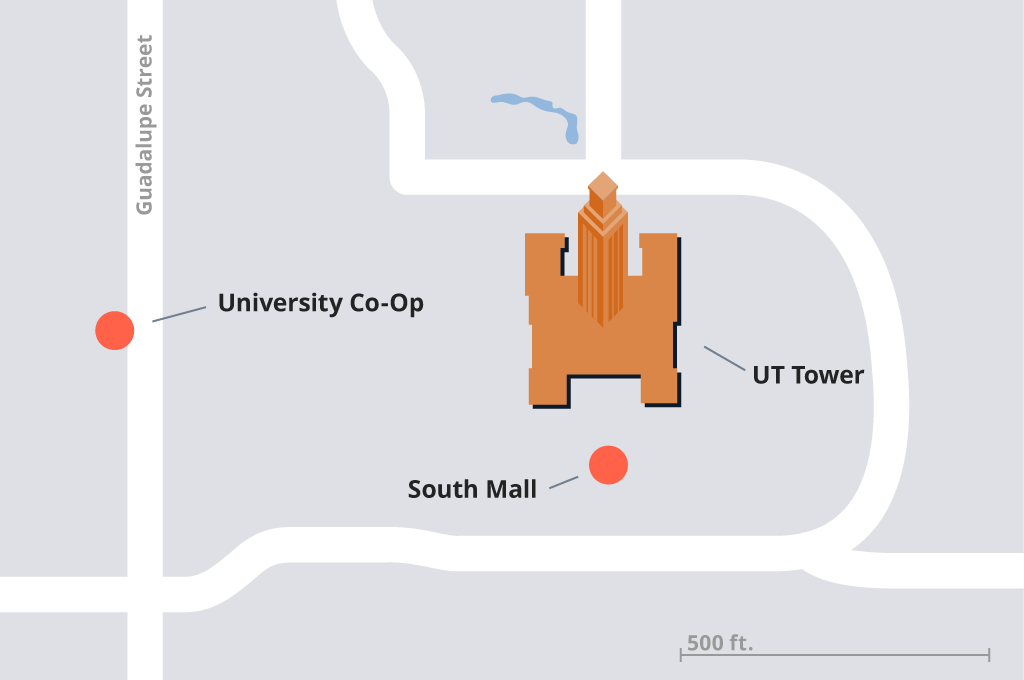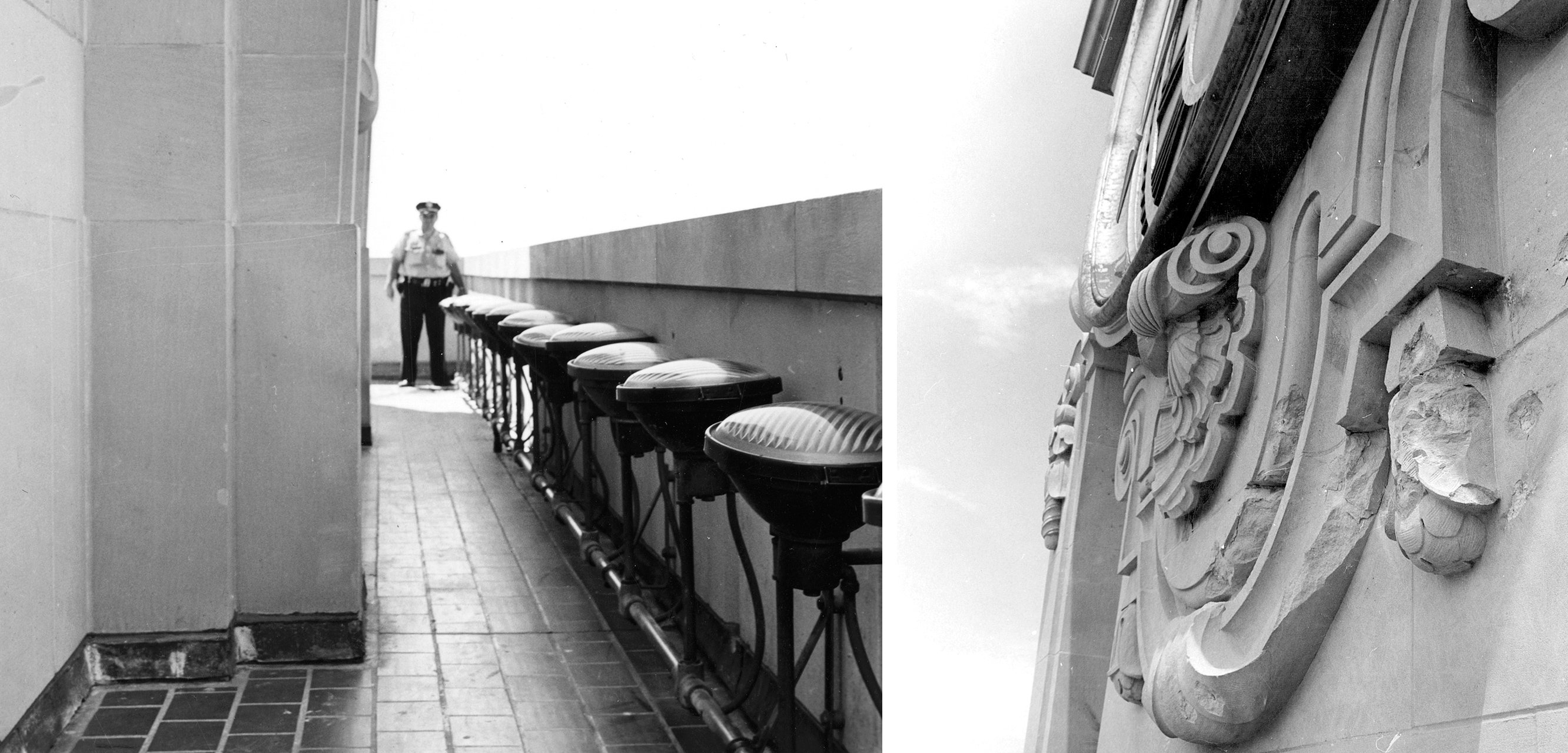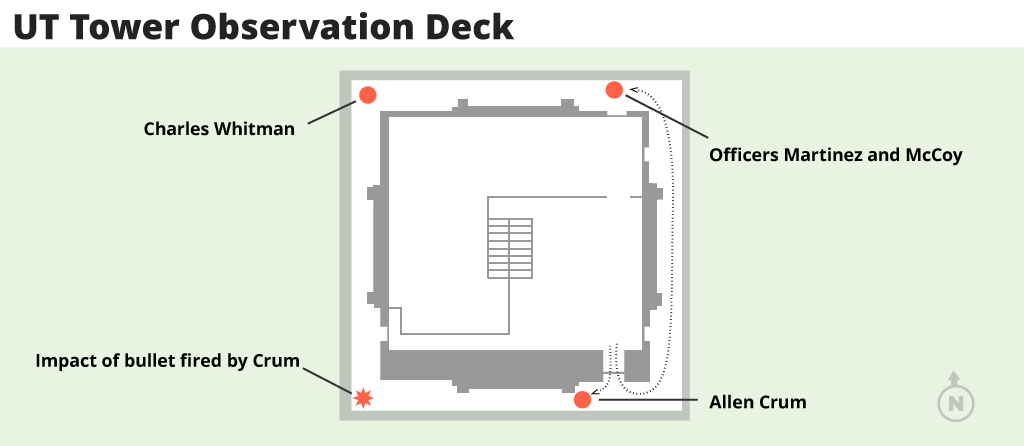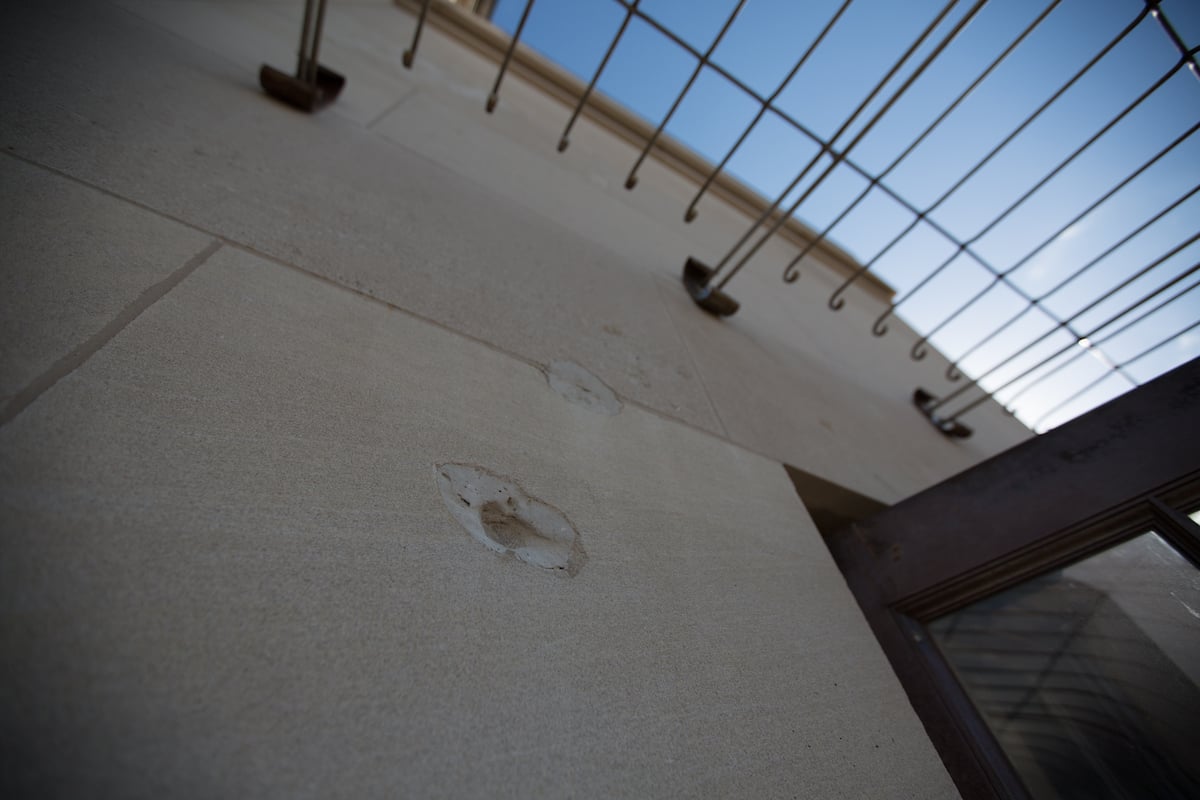The heavyset man holding a rifle seemed to know what he was doing.
Dressed like many detectives did in 1966 — with pocket liner in his shirt — he suggested to Officer Ramiro Martinez that they climb the stairs of the University of Texas Tower “service style.” With the chaos above them, there was no time for introductions.
For more than an hour, a sniper named Charles Whitman had been firing away from the tower’s observation deck. A pregnant woman, Claire Wilson, had been hit in the womb in UT’s South Mall. Some people, including a teenager on his bicycle, had been shot several blocks away. In the end, the sniper would kill 16 people that day, plus Wilson’s unborn baby. More than 30 others would be wounded.
But as Martinez and the man made their ascent to the top of the iconic tower to stop the madman, the stranger asked an unusual question: “Are we playing for keeps?”
“You’re damn right we’re playing for keeps,” Martinez later recalled answering.
“Well, you better deputize me,” the man said.
Then, it was clear. The man with Martinez wasn’t a plainclothes officer. He was a civilian — Allen Crum, one of many who armed themselves on Aug. 1, 1966, in an effort to stop the first mass shooting at an American university.
Regular people from all over Austin had grabbed their guns from their trucks or homes that day and rushed to campus to fire at Whitman from the ground. Their bullets pelted the tower, kicking up clouds of limestone. At times, witnesses said, the campus felt like a war zone, but with armed frat boys and hunting enthusiasts instead of soldiers.
It was in essence what gun rights activists would yearn for decades later whenever a new mass shooting shocked the nation — multiple “good guys with guns” trying to end the violence. That kind of thinking helped inspire state legislators to pass a law in 2015 allowing people to take guns into university buildings in Texas. The law goes into effect Aug. 1, exactly 50 years after Whitman’s rampage.
But the story of Crum, then a 40-year-old floor manager at a nearby bookstore, and the other vigilantes is complicated. On the day of the shooting, many of the armed men were reckless and unorganized. At times, they put police in danger.
“There were lots of people carrying guns, mostly young men, mainly rifles,” said Ann Major, who was a senior at the time. “There was a mood of insanity, of wildness, of craziness in the air, of pent-up frustration, of adrenaline — a wanting-to-fight-back feeling.”
There is also little doubt that they saved lives, and that police were happy for the help. No one did more than Crum, the only person off the street who reached the top of the tower with police. He was deputized by Martinez on the stairwell and later applauded by authorities for helping storm the observation deck with the officers who killed Whitman. But his daring actions also almost got him shot, and irrevocably changed his life. The violence he witnessed turned him into a different man. Years later, his son believes, its aftereffects likely drove Crum out of the state, never to return.

‘A guy’s up there’
Crum was no ordinary citizen. He spent more than two decades in the Air Force and retired as a tail gunner months before Whitman’s rampage. He lived a few blocks from Austin’s old Bergstrom Air Force Base with his wife, three kids and a pet duck.
His story that day is described in police reports, press accounts and oral histories of the shooting. He was working as a floor manager at the University Co-Op bookstore. Around noon, he looked out one of the shop windows and saw a 17-year-old newspaper delivery boy being dragged onto a patch of grass.
Thinking it was a fight, he stepped outside to break it up. But he quickly heard gunshots and noticed the boy bleeding. More shots rang out, and he realized this wasn’t an isolated fight. He warned the bookstore customers to stay away from the windows and rerouted street traffic out of harm’s way. After the roads were cleared, Crum found himself unable to return to the store safely. So he went off toward toward the tower in search of a phone.
“My wife knew that it was my lunch hour and I knew that she would worry,” he wrote in a sworn statement to police a day later.
As Crum ventured east, he ducked behind a building column to stay safe. The shooter was shifting around the square observation deck above, picking off people to the north, east and south with impeccable aim. So Crum waited until Whitman aimed elsewhere before he moved forward.
He eventually entered the tower and found a telephone. He dialed the store and his wife, Bernice, but the lines were busy. As he turned away, he saw a police officer, Jerry Day, and offered to help.
At the time, the Austin Police Department didn’t have a SWAT team. APD officers could communicate with each other from their cars, but most didn’t have portable radios. Once on foot, an officer was basically on his own.

Day tried leaning out of a third or fourth floor window and shooting toward the top of the tower. After that failed, he and Crum returned to the ground level and came across a Texas Department of Public Safety trooper named W.A. Cowan, who was carrying a handgun and an old Remington .30-caliber rifle. Crum asked if he could use the rifle, and Cowan handed it over.
More officers continued to arrive, including Martinez. Some had reached the building through the campus’ underground tunnels. Cowan, Day and Crum took an elevator to near the top. Soon after, Martinez and an officer named Houston McCoy rode the elevator up, too.
One floor below the observation deck, they found people barricaded in an office. One man, who had visited the tower with his family, was covered in blood. He had encountered the shooter on their way down from the observation deck.
“He’s killed my whole family,” the man said of the sniper.
The tourist tried to grab a weapon from the officers, but the police restrained him and sent him down the elevator with the others. Then, Martinez opened the door to a stairway that led to the observation level.
Crum walked up and asked, “Are you going up?”
“Yes, I am,” Martinez answered.
“Well, you’re not going by yourself.”
Pinning him down
Meanwhile, on the ground, students, staff and passers-by were trying their best to help police. Some were warning people not to step outside. Others were hauling off the wounded, many of whom lay bleeding in the scorching August heat.
Bob Higley, a junior at the time, and his friend Clif Drummond, who was student body president, carried 18-year-old Paul Sonntag to a car after Sonntag was shot in the mouth along Guadalupe Street. (Sonntag later died.) During the chaos, Higley said he saw two other men nearby, likely students, hiding behind trees. One was holding ammunition. The other was firing a rifle at the tower.
“They had gone to their trucks, they got their shells and they were opening fire,” Higley recalled.
Many on campus that day have similar stories. Forrest Preece, who was stuck in a drugstore on Guadalupe Street, said he remembers seeing two students running across the porch of their fraternity house carrying rifles. During a hearing on the state’s campus carry law in 2015, state Sen. Charles Schwertner, R-Georgetown, said police told his father, a student at the time, to use his rifle to fire at Whitman.
No one managed to hit Whitman, though. The tower provided a safe, comfortable perch.
A shot in the wall
As Crum and Martinez climbed the stairs, they passed some of Whitman’s first victims. They found a 16-year-old boy and his aunt dead on a landing in the stairwell. Two others — a woman and a young man — were alive but bleeding heavily. They had all been shot as Whitman made his ascent.
On the 28th floor, they found the bloody body of the observation deck receptionist, but couldn’t see the shooter. The lone door to the deck was propped closed by a metal dolly. They shoved the door open and the dolly clanged loudly. Then, Crum with his rifle and Martinez with a pistol stepped outside. Day and McCoy, carrying a shotgun, came out soon after.
Crum turned toward the west, while Martinez headed north on the east side. In his report to police, Crum said he heard footsteps crunching on the chipped limestone on the west side of the deck. He fired a shot straight into the corner wall. But no one rounded the corner.

Moments later, Martinez turned the northeast corner. Whitman was at the other end of the north side, sitting with his back to the wall. A gunfight erupted. Martinez fired his handgun until it ran out of bullets. Whitman shot back, but his rifle was aimed too high. Then, McCoy rounded the corner and fired his shotgun twice. Both blasts hit Whitman in the head. In a surge of adrenaline, Martinez grabbed the shotgun and pumped one more shot into Whitman’s shoulder.
The sniper was dead.
Thousand-yard stare
Crum didn’t get a chance to make his phone call home until hours later. His family had been watching television coverage of the shooting. They assumed he had been holed up safely in the bookstore.
Crum’s son, David, said he remembers the call only lasting a minute or two. His mother asked his father a couple of quick questions, “Are you kidding me?” and “Are you alright?”
Then, she hung up, walked into the living room and said, “Your dad was involved in the shooting.”
The family didn’t know the extent until later. When Crum finally came home, he went into a bedroom to talk alone with his wife for what seemed like hours. Then, he walked out and told his children that he had been at the top of the tower. There was no description or harrowing tale. But David, who was 13 at the time, could tell that his dad had experienced something traumatic.
“He was very different at that point,” David Crum said. “He had seen something that he didn’t want to see.”
From that point on, he seemed more distant. He almost never wanted to talk about the incident, and he always had a “thousand-yard stare,” his son said.
In 1972, Crum suddenly decided to leave town. By then he was working at Tracor, an Austin-based defense contractor. One day, his shift ended and he walked to his car and drove west, his son said. Once he reached El Paso, he called his wife and told her that he was heading to Las Vegas. He was either going to strike it big, or the family was going to go broke, he said, according to his son.
Bernice moved out there with him soon after. David, by then over 18, stayed behind. Allen Crum never returned to Texas, not even for his son’s wedding.
In Las Vegas, he worked as a slot machine repairman and casino floor manager. He loved the desert city, less because of its bright lights than because of the sparse terrain of its outskirts. He read constantly, and he had a whole room in his house devoted to model trains. He’d spend hours working in that room building small cities with working traffic lights. It always seemed to his son like he was trying to take his mind off what happened on Aug. 1, 1966.
“That day, I lost my father,” David Crum said.
No accident
Allen Crum died in 2001. But each year, the anniversary of the shooting still weighs on his son.
“I have often wondered to myself why,” David Crum said. “Why did you get involved? What caused you to move in that direction? Why didn’t you stand still?”
In later years, many historians and police came to believe that Crum fired his shot into the wall accidentally. He was holding a gun he was unfamiliar with, they say, and was surely nervous. David said his dad told him otherwise. He hears the speculation every year and is infuriated.
“My father is not an idiot,” he said.
Either way, there’s no question that Crum and the other vigilantes helped. In the days after the shooting, Austin Police Chief Bob Miles said their gunfire helped pin Whitman down and likely limited the number of victims. At the start of the shooting, Whitman was aiming over a low wall. Once return fire started, he was forced to aim through three spouts on each side, which were designed to funnel rainwater off the deck in a storm.

“And most important, it was not irresponsible shooting,” the chief told the Austin American-Statesman soon after. “They were shooting at the target.”
Gun rights supporters occasionally bring up UT’s gun-wielding citizens when they advocate for campus carry laws like the one going into effect Monday. Opponents note, however, that law enforcement has changed over the decades. With SWAT teams, police snipers and better active shooter response plans, police are much better equipped to handle those disasters.
The potential downfalls remain the same, gun control activists say. On that day in 1966, the shooting from the ground put innocent lives at risk. When Crum and the police were at the top, bullets whizzed past them. Officer McCoy later reported that a bullet slammed into a wall just inches from his head. The incoming fire kept coming even after Whitman was killed. It only stopped when Crum waved a handkerchief over the observation deck wall.
“To me, it is miraculous that friendly fire didn’t result in any kind of casualty,” said Gary Lavergne, author of “A Sniper in the Tower,” the definitive book on the Whitman shooting.
But for Crum and others, the urge to help outweighed the risks. In 1991, 25 years after the shooting, he gave a rare interview to the Austin American-Statesman. He offered the most detailed public explanation for why he went to the tower that day.
He remembered the famous story of Kitty Genovese, who was stabbed to death outside her apartment in Queens, New York, in 1964. According to reports at the time, dozens of people witnessed the attack from their homes, but no one called the police.
“That story stuck in my mind,” Crum said. “I couldn’t just stand there.”
Disclosure: The University of Texas has been a financial supporter of The Texas Tribune. A complete list of Tribune donors and sponsors can be viewed here.
To republish this story for free, click here or email editors@texastribune.org.
A note on sources
This story is based on interviews with multiple people connected to the shooting as well as numerous police documents, written remembrances and press clippings from the Austin American-Statesman, Dallas Morning News, Houston Chronicle, Associated Press and Life magazine. Documents consulted include a sworn statement written by Allen Crum for police the day after the shooting; a transcript of an interview Crum gave to American Rifleman magazine; a written remembrance by Officer Houston McCoy at the Austin History Center and a transcript of an interview with Officer Ramiro Martinez for The Texas Ranger Hall of Fame. Gary Lavergne’s book “A Sniper in the Tower” also provided valuable information.
Join the conversation
The Texas Tribune encourages a diverse and constructive dialogue on the issues we cover. That’s why we’re experimenting with a new discussion tool called Civil Comments, which allows our readers to help maintain the quality of our comments through peer review. To post a comment in this discussion, you’ll also be asked to rate another Tribune reader's comment. The process is quick, and you can log in with Twitter, Facebook or email. Thanks for experimenting with us, and we look forward to hearing what you think. Send us your thoughts at feedback@texastribune.org. .
Comment policy
The Texas Tribune pleased to provide the opportunity for you to share your observations about this story. We encourage lively debate on the issues of the day, but we ask that you refrain from using profanity or other offensive speech, engaging in personal attacks or name-calling, posting advertising, or wandering away from the topic at hand. To comment, you must be a registered user of the Tribune, and your real name will be displayed. Thanks for taking time to offer your thoughts.